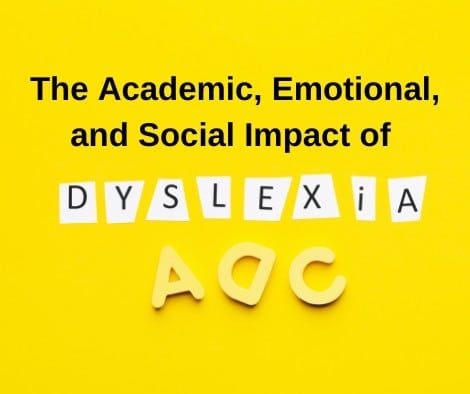
In this article, we delve into the academic, emotional, and social impact of developmental dyslexia, the effect on family dynamics, the role of teachers and parents in supporting dyslexic students, and the importance of intervention.
Developmental dyslexia is a learning disability that affects individuals of all ages and backgrounds. It is characterized by great trouble reading, writing, and spelling and is often associated with phonological processing, working memory, and processing speed challenges.
We specialize in helping children overcome the symptoms of dyslexia. Book a free consultation to discuss your child’s learning needs.
Table of contents:
- Brief overview of developmental dyslexia
- Academic challenges
- Emotional and social impact
- Effect on family dynamics
- Role of teachers and parents
- Importance of intervention
- Summary and conclusion
Brief overview of developmental dyslexia
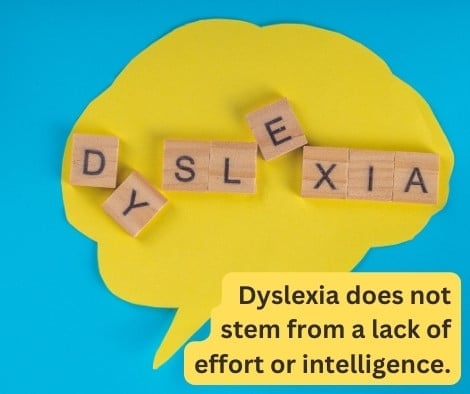
Developmental dyslexia is a common learning disorder that manifests as reading, spelling, and spelling challenges. It often causes difficulties in decoding, understanding, and recalling written words, impacting learning across different subjects. These difficulties often stem from phonological processing, processing speed, and working memory issues.
There are two broad categories of dyslexia: acquired and developmental. Acquired dyslexia occurs when a good reader and speller loses some of their reading or spelling ability due to a brain injury. Developmental dyslexia (hereafter called dyslexia) occurs when children have trouble with reading and spelling from the outset.
Dyslexia does not stem from a lack of effort or intelligence. Dyslexic individuals are often bright, creative, and talented in other areas. This invisible handicap involves diverse symptoms and impacts and is not just about reversing letters or words.
Academic challenges
Students with dyslexia have difficulty reading, spelling, and writing, which causes them to display low academic achievement and have a higher risk of dropping out of school.
Difficulty in reading
Reading is how students get information from books, computers, and worksheets to learn literature, math, science, social studies, and more. As much as 85 percent of the curriculum is taught by reading. Therefore, children who are not reading on grade level by the end of third grade struggle in every class, year after year.
Struggling with written words is a common challenge for dyslexic individuals. The difficulty in decoding, understanding, and recalling written words can significantly impact learning across various subjects.
Struggle with writing

Writing is critical because it’s used extensively in higher education and the workplace. If students don’t know how to express themselves in writing, they won’t be able to communicate well with professors, employers, or peers. Much of professional communication is done in writing: proposals, memos, reports, applications, preliminary interviews, e-mails, and more are part of the daily life of a college student or successful graduate.
Expressing oneself in writing can be particularly demanding for dyslexic individuals, who often encounter difficulties with spelling, grammar, punctuation, and sentence structure.
Impact on academic performance
Dyslexia influences children’s ability to read, spell, organize, and comprehend ideas, significantly affecting their academic performance since reading, comprehension, and writing are involved in all subject courses. Consequently, children with dyslexia typically display a low achievement in academics, which leads to a high drop-out rate in school and less chance to finish school than peers who are not suffering from dyslexia.
Impact on future employment
Many dyslexic adults are underemployed, often stuck in dead-end jobs that do not tap into their true vocational potential. Many others are not finding employment at all. They are unsuccessful in pursuing further training, and few are accessing the adult services developed to serve them. Many have major academic and vocational needs that make it hard to live independent lives.
However, the salary check figures might be just one of many concerns since dyslexia can have destructive emotional effects.
Emotional and social impact
Students with dyslexia may experience shame, anxiety, social isolation, sadness, lack of self-confidence, and emotional problems daily.
Feelings of anxiety and frustration
Dyslexic students may encounter anxiety, stress, and frustration in learning situations, which can significantly impact their motivation. Some children with dyslexia may present school phobia and show psychosomatic symptoms such as vomiting, chest pain, and stomachache. Most of these symptoms resolve when the child does not have to go to school, for example, on weekends and vacations.
Dealing with anger and depression
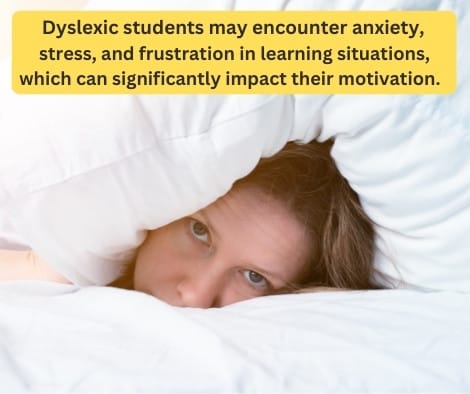
Frustration and sadness — even intense feelings of sorrow — can often arise in dyslexic students due to their challenges. Many of the emotional problems caused by dyslexia occur out of constant frustration with school or social situations. Social scientists have frequently observed that frustration produces anger, which can be seen in many people with dyslexia. These emotions may impact their emotional well-being, requiring a supportive and understanding approach to address their anger and depression effectively.
A study by the University of Toronto found that the lifetime prevalence of suicide attempts was much higher for women who had been diagnosed with learning disabilities (16.6%) compared to women who had not (3.3%). Men with learning disorders were also more likely to have attempted suicide compared to men without (7.7% vs. 2.1%).
Social challenges
Dyslexia can affect personal relationships, causing social problems and strained interactions. A survey showed that students with learning disorders suffer school bullying at a rate double to ten times the usual due to their degrading school failure.
Negative self-image and low confidence
Individuals with dyslexia often suffer from a negative self-image and low self-esteem. This low self-esteem usually comes from the struggles, frustration, and loneliness they have experienced. Beyond having to deal with trouble at school, a child with dyslexia may also be subjected to ridicule from other children and pressure from adults who do not understand dyslexia.
Behavior problems
Behavior problems resulting from their negative experiences are not uncommon in dyslexic youngsters. The strain and frustration of underachieving can cause them to be reluctant to go to school, throw temper tantrums before school, or sometimes play truant. Cheating, stealing, and experimenting with drugs can also result when children regard themselves as failures.
Compared to typical learners, adolescents with learning disabilities, including dyslexia, have been found to have twice the risk of emotional distress, including risk for violence and suicide attempts (Svetaz, Ireland, & Blum, 2001).
Dyslexia can destroy lives. To get a disturbing sense of this, we need only look at the estimates of learning disorders among juvenile delinquents. Results from a study in the U.S.A. by the National Center for State Courts demonstrated that youths with learning disorders were 200 percent more likely to be arrested than nondisabled peers for comparable offenses. According to the U.S. Department of Education, 60 percent of America’s prison inmates are illiterate, and 85 percent of all juvenile offenders have reading problems.
Effect on family dynamics
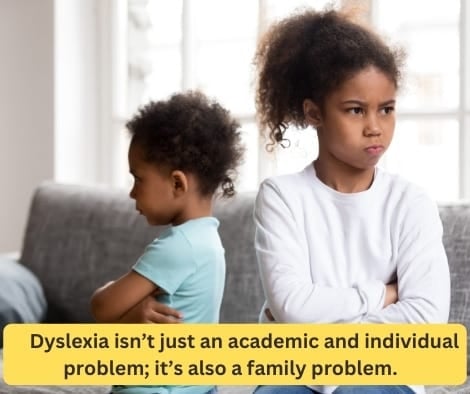
Dyslexia isn’t just an academic and individual problem; it’s also a family problem. Having a child with a learning disability impacts the entire family. Parents, brothers, sisters, and even grandparents become involved, must adjust, and are changed in the process.
The dream of a boy or girl who tops the 1st-grade reading groups and shines in the spelling bee is shattered and replaced by the recognition that maybe years of reading help lay ahead. Millions of families live this reality daily, but not without it taking a toll on every family member and changing them somehow.
The strain on parent-child relationships
Children with dyslexia may experience emotional pain and avoidance behavior that can impact relationships at home and cause strained parent-child relationships.
Impact on siblings and family cohesion
The existence of dyslexia within a family dynamic can create a challenging environment where family members may struggle to understand and cope with the complexities of the condition. In some families, learning disorders can produce sibling rivalry. The emotional well-being of the family as a whole can be significantly affected, resulting in a need for additional support and understanding from all members.
Role of teachers and parents
Adequate support from teachers and parents is crucial for dyslexic students. Collaboration between teachers and parents is paramount for the success of dyslexic students, ensuring that their academic and emotional needs are met.
Effective teaching strategies for dyslexic students
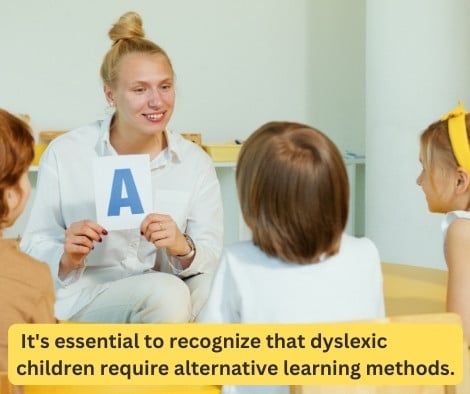
Effective teaching strategies play a vital role in assisting dyslexic students to overcome language challenges and excel in school activities. These students benefit greatly from strategies emphasizing developing social skills and handling social situations. Teachers should offer emotional support, guiding dyslexic students through social interactions and language problems.
It’s essential to recognize that dyslexic children require alternative learning methods, and implementing effective teaching strategies can significantly aid them in adapting to new learning environments. Teachers can employ multisensory instruction, assistive technology, and personalized learning to address their unique needs. Additionally, creating a supportive and inclusive classroom environment is essential.
How parents can provide emotional support
Parents play a vital role in advocating for their children, fostering a positive attitude toward learning, and providing a nurturing and safe home environment. Understanding the impact of dyslexia on social relationships and language issues enables parents to guide their children through these difficulties. Parents can help mitigate the powerful feelings of anxiety and frustration that are common among dyslexic children, allowing them to thrive emotionally.
Importance of intervention

Intervention for dyslexia is crucial in ensuring that individuals receive the support they need to thrive academically and emotionally. Identifying learning disorders in younger children can help provide appropriate interventions, prevent further challenges, and foster a safe home and school environment.
Screening and assessment for dyslexia
Early detection allows for effective intervention programs and strategies, ultimately leading to better outcomes for dyslexic individuals. The International Dyslexia Association emphasizes the importance of early screening and assessment, as it paves the way for tailored support and prevents the exacerbation of academic and emotional struggles.
Effective intervention programs for dyslexic students
While early intervention is best, the intervention program must also meet specific criteria. Otherwise, it might have little impact academically and make little difference to the child’s life.
- Effective intervention programs are aligned with the Orton-Gillingham approach.
The Orton-Gillingham (OG) approach is a direct, explicit, multisensory, structured, sequential, diagnostic, and prescriptive way to teach literacy when reading, writing, and spelling don’t come easily to individuals, such as those with dyslexia. In the hands of a well-trained and experienced instructor, it is a powerful tool of exceptional breadth, depth, and flexibility.
- Effective intervention programs develop cognitive skills.
Intervention programs should improve cognitive skills like focused and sustained attention; phonological and phonemic awareness; visuospatial abilities; processing speed and rapid naming; and visual, auditory, sequential, iconic, short-term, and working memory.
- Effective intervention programs target two crucial brain areas.
Research shows that a network of brain regions is involved in learning to read, one specifically in sounding out words and another in seeing words as pictures. The picture area is located in the left occipitotemporal region and is known as the visual word form area (VWFA) or visual dictionary (Brem et al., 2020). Both the sounding out area and the VWFA must be trained in teaching reading.
- Effective intervention programs are based on fundamental learning principles.

Since teaching reading is ultimately an educational matter, we should recognize that specific learning principles are involved. It is not just the WHAT of teaching that matters. It is also the HOW. Applying certain educational learning principles is a core aspect often overlooked in dyslexia interventions.
By combining cognitive training with the systematic teaching of reading while simultaneously applying fundamental learning principles, the way is paved to improve the reading, writing, and learning abilities of dyslexic children — and even help them completely overcome their challenges.
While children do not ‘outgrow’ dyslexia, its symptoms can be overcome when followed by the four intervention principles mentioned above. Below are success stories of children who overcame their dyslexia symptoms and the difference it made to their lives:
Summary and conclusion
Academic, emotional, and social impact of dyslexia: Summary
In this article, we delved into the academic, emotional, and social impact of dyslexia, the effect on family dynamics, the role of teachers and parents in supporting dyslexic students, and the importance of intervention.
Dyslexia can impact children and adults in a variety of ways. Dyslexic students have difficulty reading, spelling, and writing, which causes school problems, such as low academic achievement and a higher risk of dropping out of school. The learning disorder can cause great pain. Dyslexic individuals may experience shame, anxiety, anger caused by continuous frustration, feelings of inferiority, social isolation, sadness, and other negative thoughts affecting their mental health.
Dyslexia isn’t just an academic and individual problem; it’s also a family problem. Having a child with a learning disorder impacts the entire family. Therefore, adequate support from teachers and parents is crucial. Collaboration between teachers and parents is essential to ensure the dyslexic child’s academic and emotional needs are met.
The International Dyslexia Association emphasizes the importance of early screening and assessment, as this allows for effective intervention programs and strategies, leading to better outcomes for dyslexic individuals. The intervention program must meet specific criteria. Otherwise, it might have little impact academically and make little to no difference to the child’s life.
Academic, emotional, and social impact of dyslexia: Conclusion?
The academic, emotional, and social impact of dyslexia can be lessened and eventually eradicated through intervention and treatment, thereby changing the child’s school experience into a positive one. This handicapping condition can be beaten, turning painful feelings into positive feelings and depressed youngsters into enthusiastic children.
